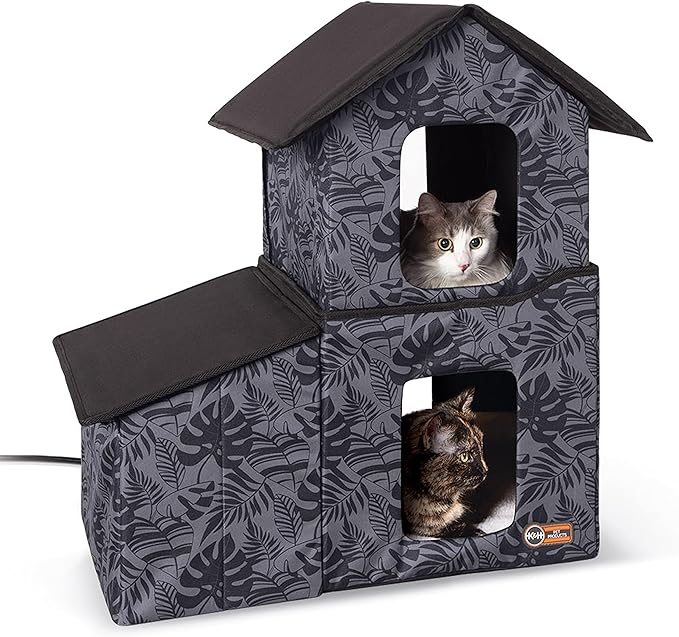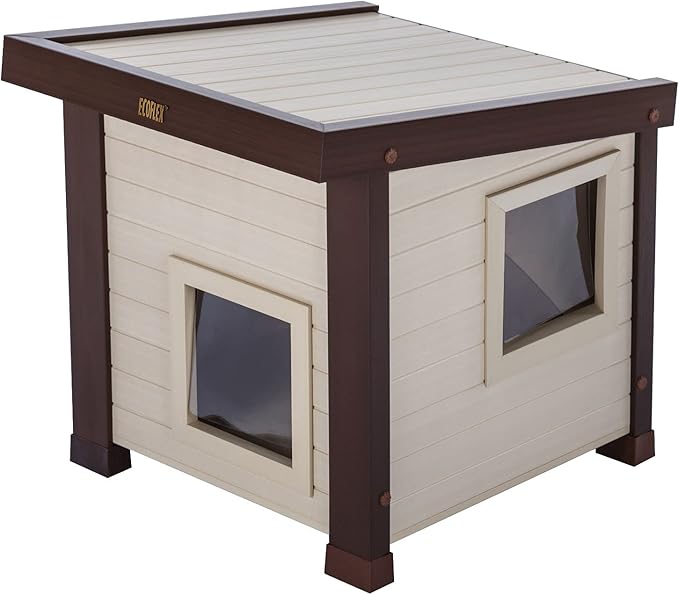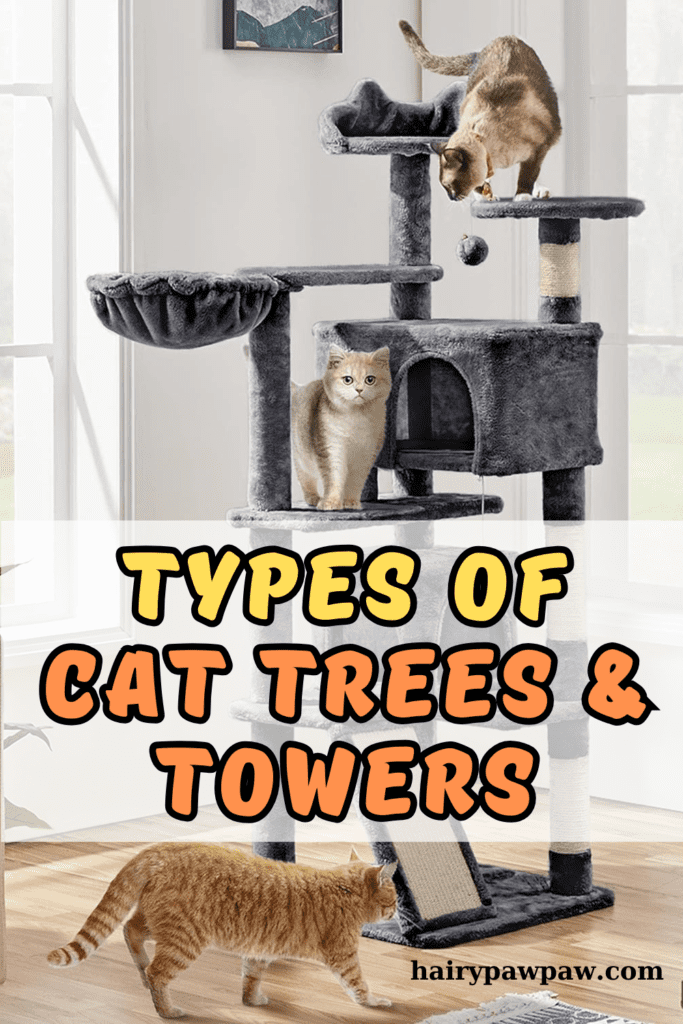Outdoor Cat Houses: The Best Ones and How to Make Your Own
This post may contain affiliate links, which means I’ll receive a commission if you purchase through my link, at NO EXTRA COST TO YOU
As cat owners, we always want the best for our furry companions, and providing them with a safe, comfortable space outdoors is no exception. Outdoor cat houses offer a perfect solution for felines who enjoy the fresh air but need protection from the elements. In this comprehensive guide, we’ll explore everything you need to know about outdoor cat houses, from the benefits they offer to the different types available, and even some tips for choosing the right one for your cat. Let’s dive in!

Why Invest in an Outdoor Cat House?
Outdoor cat houses serve as a haven for cats who love spending time outside. They provide:
- Protection from Weather: Whether it’s rain, snow, or harsh sun, an outdoor cat house shields your cat from extreme weather conditions.
- Safety from Predators: A well-constructed cat house can keep your cat safe from potential predators like coyotes, foxes, and larger birds of prey.
- Comfort and Privacy: Cats appreciate having their own space where they can retreat, relax, and feel secure.
- Support for Feral Cats: Outdoor cat houses are also an excellent option for helping stray and feral cats, offering them a warm, dry place to sleep.
Types of Outdoor Cat Houses
Outdoor cat houses come in various designs, materials, and sizes. Understanding the options available will help you choose the best one for your feline friend.
Insulated Cat Houses
- Features: Insulated cat houses are designed to provide warmth during cold weather. They often include thermal insulation materials like Styrofoam or reflective lining to retain heat.
- Best For: Cats living in colder climates or outdoor cats who spend a lot of time outside during the winter.
Heated Cat Houses
- Features: Equipped with heating pads or electric heaters, these houses ensure that your cat stays warm even in freezing temperatures. Many models come with removable heating elements for easy cleaning.
- Best For: Cats that need extra warmth, particularly in areas with harsh winters.
Weatherproof Cat Houses
- Features: Made with materials like heavy-duty plastic, treated wood, or waterproof fabric, these houses are built to withstand rain, wind, and snow. They often include raised floors and sloped roofs for added protection.
- Best For: Cats that live in regions with unpredictable or severe weather conditions.
Multilevel Cat Houses
- Features: These houses offer multiple levels and compartments, providing cats with more space to explore and hide. They are often designed with ramps, perches, and entry/exit points.
- Best For: Cats that enjoy climbing, playing, and having multiple hiding spots.
Portable Cat Houses
- Features: Lightweight and easy to assemble, portable cat houses are perfect for temporary outdoor use or for families who travel frequently. They are typically made of fabric and can be folded for easy storage.
- Best For: Cat owners who need a versatile and mobile shelter solution.
Materials and Durability
When selecting an outdoor cat house, consider the materials used in its construction. The most common materials include:
- Wood: Sturdy and traditional, wood is a popular choice for outdoor cat houses. Look for weather-treated or sealed wood to ensure longevity and resistance to moisture.
- Plastic: Durable and easy to clean, plastic cat houses are often more affordable. They are also resistant to rot and insect damage.
- Fabric: Used primarily in portable models, fabric cat houses are lightweight and convenient but may not offer the same level of protection as wood or plastic houses.
Key Features to Look For
To ensure you’re getting the best outdoor cat house for your pet, consider the following features:
- Size and Space
- Make sure the house is spacious enough for your cat to move around comfortably. If you have multiple cats, consider a larger model with separate compartments.
- Insulation and Heating
- If you live in a colder climate, insulation and optional heating elements are crucial. Ensure the house has proper ventilation to avoid overheating in warmer months.
- Ease of Access
- Look for a cat house with easy entry and exit points, especially if your cat is older or less agile. Some houses have multiple doors for added convenience.
- Assembly and Maintenance
- Choose a model that is easy to assemble and clean. Removable roofs or doors can make maintenance much simpler.
- Stability and Security
- The house should be stable and secure, preventing it from tipping over or being moved by strong winds. Anchor points or weighted bases are beneficial.
- Aesthetic and Design
- While functionality is key, the appearance of the cat house can also be important. Choose a design that complements your outdoor space or home exterior.
Top 5 Outdoor Cat Houses on the Market
Petsfit Outdoor Cat House
- Features: Made of solid cedar wood, weatherproof, insulated floor.
- Pros: Durable, easy to assemble, and aesthetically pleasing.
- Cons: Slightly more expensive than other options.
K&H Pet Products Outdoor Heated Kitty House
- Features: Heated, waterproof, two exits with removable clear door flaps.
- Pros: Excellent for cold weather, easy to set up.
- Cons: Requires access to electricity for heating.
The Kitty Tube Outdoor Cat House
- Features: Fully insulated, weatherproof, includes straw for bedding.
- Pros: High-quality insulation, spacious, and secure.
- Cons: Large size may not be suitable for small outdoor spaces.
EcoFLEX Albany Outdoor Feral Cat House
- Features: Made from EcoFLEX, a durable, weather-resistant material.
- Pros: Easy to clean, resistant to moisture and pests.
- Cons: Limited insulation for colder climates.
Trixie Pet Products Wooden Outdoor Cat House
- Features: Two-story design, elevated floor, weatherproof finish.
- Pros: Offers multiple levels and hideaways, sturdy construction.
- Cons: Assembly can be time-consuming.
DIY Outdoor Cat Houses: A Personal Touch
If you’re handy with tools and enjoy DIY projects, creating your own outdoor cat house can be a rewarding experience. Here’s a basic guide to building a simple outdoor cat house:
- Materials Needed:
- Plywood or weather-treated wood
- Insulation materials (Styrofoam or foam board)
- Waterproof sealant
- Nails, screws, and basic tools
- Steps:
- Measure and Cut: Start by cutting the wood to your desired dimensions. Ensure the house is large enough for your cat to move around comfortably.
- Assemble the Frame: Construct the base, walls, and roof of the house. Secure all joints with screws or nails.
- Insulate: Line the inside of the house with insulation material to keep it warm in winter.
- Waterproof: Apply a waterproof sealant to the exterior to protect it from rain and moisture.
- Add Finishing Touches: Install a door flap for easy access, and consider adding a removable roof for easy cleaning.
- Customization:
- Paint the house to match your outdoor décor.
- Add a small porch or overhang to provide additional shelter from the elements.
- Incorporate a heating pad for extra warmth.
Maintaining Your Outdoor Cat House
Regular maintenance of your outdoor cat house is essential to ensure it remains a safe and comfortable environment for your cat.
- Clean Regularly: Remove any debris, old bedding, or food to prevent pests from settling in.
- Check for Damage: Inspect the house periodically for any signs of wear, such as cracks, leaks, or loose parts, and repair them promptly.
- Replace Insulation: If your cat house uses insulation, replace it as needed to maintain warmth during colder months.
- Refresh Bedding: Provide fresh, clean bedding regularly, especially if your cat spends a lot of time outdoors.
Conclusion
Outdoor cat houses are an invaluable investment for any cat owner who wants to provide their feline friend with a safe, comfortable space outside. Whether you purchase a pre-made house or embark on a DIY project, ensuring your cat has a warm, dry, and secure shelter is essential. With the variety of options available, you’re sure to find the perfect outdoor cat house that suits your cat’s needs and your personal preferences.
By considering factors such as insulation, materials, and size, you can make an informed decision that will keep your cat happy and healthy. Whether your cat is a seasoned outdoor explorer or a feral feline in need of shelter, the right outdoor cat house can make all the difference.















